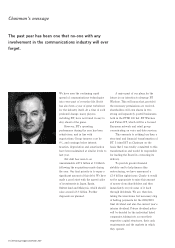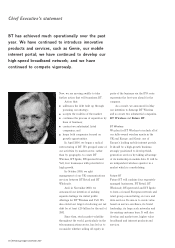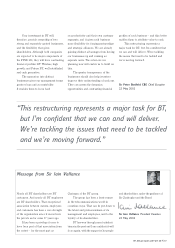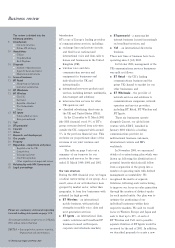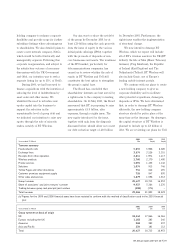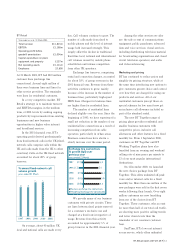BT 2001 Annual Report Download - page 14
Download and view the complete annual report
Please find page 14 of the 2001 BT annual report below. You can navigate through the pages in the report by either clicking on the pages listed below, or by using the keyword search tool below to find specific information within the annual report.
Business review
14 BT Annual report and Form 20-F
The UK market grew rapidly during
the 2001 ¢nancial year and remained
extremely competitive, re£ecting
signi¢cant demand for competitively
priced pre-pay products.
BT Cellnet launched General Packet
Radio Service (GPRS) services in June
2000. In the UK Government’s 3G licence
auction, which concluded in April 2000,
BT obtained a licence for »4.03 billion to
operate 3G mobile services.
In April 2000, BT Cellnet purchased,
for »45 million, the 60% of The Mobile
Phone Store that it did not already own, as
part of BT Wireless’ initiative to obtain
increased control over its distribution
channels.
Germany
BT Wireless’ German operations are
conducted through Viag Interkom, which,
since February 2001, has been our wholly-
owned subsidiary. Viag Interkom
launched mobile telephony services in
October 1998 as the fourth entrant into the
German market and, by 31 March 2001,
had achieved an estimated 7% market
share with over 3.7 million customers.
Viag Interkom’s turnover, including its
¢xed business, for the year ended 31 March
2001 was »1,078 million, with negative
EBITDA for the same period of »407
million before exceptional items. The ¢xed
business market formerly addressed by
Viag Interkom is now served by BT Ignite
Germany.
TheGermanmarketiscurrentlya
highly competitive four-player market,
and two further entrants are possible
following the auction of six 3G licences
carried out by the German Government in
August 2000. Viag Interkom holds one of
the 3G licences, which was purchased for
»5.13 billion.
The construction of Viag Interkom’s
Global System for Mobile communications
(GSM) network is ongoing. It currently
covers an estimated 81% of the German
population, but a national roaming
agreement with T-Mobil allows Viag
Interkom to o¡er service covering
approximately 99% of the German
population.
Viag Interkom launched GPRS
services in January 2001.
Viag Interkom is developing other
initiatives to achieve a greater share of the
business market, such as cooperation
arrangements with specialised service
providers. It is also seeking to improve
network costs per minute by increasing
use of its network from selected wholesale
opportunities and by other initiatives,
such as outsourcing functions to achieve
cost e⁄ciencies.
Republic of Ireland
Our wireless operations in the Republic of
Ireland are conducted through Esat
Digifone, which became a wholly-owned
subsidiary in April 2001. Esat Digifone
entered the Irish market in March 1997
and, by 31 March 2001, it was serving over
1.1 million customers, representing an
estimated market share of approximately
41%. Esat Digifone’s turnover for the year
ended 31 March 2001 was »312 million,
with EBITDA for the same period of »69
million. Esat Digifone expects to apply for
oneofthefourlicencestobeo¡eredbythe
Irish Government to build and operate a
3G network in Ireland.
The Netherlands
Telfortlauncheditsservicein1998inthe
Dutch mobile market. It now has a
network covering over 97% of the
population and more than 918,000
customers representing an estimated
market share of approximately 8%.
Telfort’s turnover, including its ¢xed
business, for the year ended 31 March 2001
was »301 million, with negative EBITDA
for the same period of »118 million before
exceptional items. The ¢xed business
market formerly addressed by Telfort is
now served by BT Ignite Netherlands.
Telfort was awarded a 3G licence in
July 2000 for »267 million.
Genie
GenieisBT’smobileinternetportal,
comprising web and WAP portals in the
UK, France, Germany, Hong Kong, Italy,
The Netherlands and Spain. With more
than four million registered customers,
according to Red Sheri¡ Services’ data
collection software, Genie is one of the
major players in the mobile internet portal
market, o¡ering content including
entertainment, m-commerce, games, and
the latest sports, news and business
information.
Geniealsofunctionsasan
Application Service Provider (ASP) to
network operators, o¡ering hosted, secure
access to enterprise applications through
an integrated customised portal, and
provides mobile internet communications
and portal services on a hosted basis in the
Asia-Paci¢c region.
In November 2000, Genie launched
the UK’s ¢rst exclusively online mobile
service, o¡ering mobile phones with
mobile internet access through text
messaging and WAP.
By o¡ering high quality content and
applications and developing personalised
relationships with our customers, we believe
Genie will assist in increasing average
revenues per user and reducing churn.


